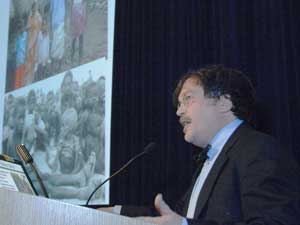Hotez outlines advances and challenges in fighting neglected diseases
June 2010 | Volume 9, Issue 3

Photo by Bill Branson
Dr. Peter J. Hotez
By Anne A. Oplinger
The world's "bottom billion" - subsistence farmers, urban poor and all who live on less than a dollar a day - have suffered the consequences of extreme poverty for generations. The most destitute are not only poor, says Dr. Peter J. Hotez, they are also chronically ill. A group of infectious illnesses, collectively termed neglected tropical diseases, are largely to blame for keeping the bottom billion in poverty. Recent attention to these previously neglected maladies is beginning to pay off, says Hotez, professor and chair of George Washington University's department of microbiology, immunology and tropical medicine.
Hotez, who is also president of the Sabin Vaccine Institute and a Fogarty advisory board member, described advances in combating neglected tropical diseases - and outlined the challenges that remain - at the 2010 John Ring LaMontagne Memorial Lecture at NIH. LaMontagne was deputy director of the National Institute of Allergy and Infectious Diseases.
Unlike HIV, TB or malaria, says Hotez, the seven most common neglected tropical diseases typically do not kill people. These chronic infections, including six caused by parasitic worms, tend to debilitate victims. The effects are both individual and societal.
Aside from causing profound suffering, the neglected diseases also hold back entire economies, says Hotez. In India alone the disfiguring and disabling parasitic disease called elephantiasis is estimated to cause worker productivity losses totaling $1 billion annually.
"That's the bad news. The good news is we can treat neglected diseases, often at very little cost per treated person," Hotez says. For example, safe and effective anti-worming medications have been successfully used in nationwide mass administration efforts, he adds.
Some of the current projects of the Sabin Vaccine Institute include initiatives aimed at developing vaccines against hookworm and schistosomiasis. If successful, such vaccines could do much to alleviate disease and destitution among the bottom billion.
To view Adobe PDF files,
download current, free accessible plug-ins from Adobe's website.